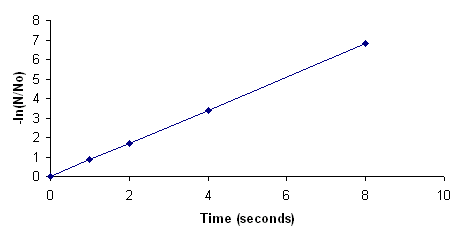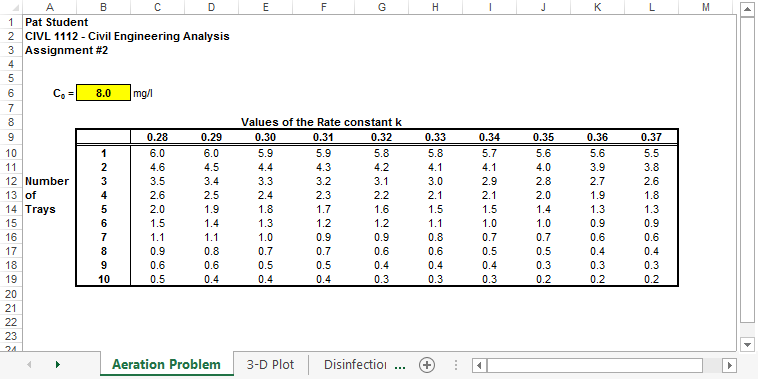|
"I am always ready to learn, but I do not always like
being taught." Winston Churchill
Part
One: Solve the following three
problems (you are not required to use an Excel spreadsheet)
Carbon Dioxide Removal #1
- A groundwater containing 30 mg/l of carbon dioxide is to be
degasified using a multiple-tray aerator with six trays. In this water
treatment facility, ten aerators operating in parallel. For
maintenance reasons, only nine of the aerators are available at
any one time. The design population is 50,000 persons, and the maximum day demand is
150
gal/person-day. The k value is 0.33, and the hydraulic loading is
3
gpm/ft2. Determine:
The carbon dioxide content of the product water.
The size of the trays if the length-to-width ratio is 2:1 and the trays
are made to 1 inch increments.
Solution: The performance equation is:

Therefore: C = (30 mg/l)e-6(0.33) = (30
mg/l)(0.138) = 4.1 mg/l
The flowrate to each parallel aerator is:

The area of each parallel aeration tray is:

Since L = 2W, then the area of each aerator is A =
W(2W) = 192.9 ft2
W = 9.82 ft or 9 ft - 10 in
L = 2W or 19 ft - 8
in
Carbon Dioxide Removal #2
- A groundwater containing 25
mg/l of carbon dioxide is to be degasified using a multiple-tray aerator. The design
population is 250,000 persons, and the maximum day demand is 150 gal/person-day. The k
value is 0.32, and the hydraulic loading is 4 gpm/ft2. Determine:
Determine the total number of trays in an aerator
required to reduce the product water's carbon dioxide content by 90%.
Determine the number of aerators, operated in parallel,
required for the water treatment facility if each tray's size is 1,000 ft2.
Solution: The performance equation is:

Rewriting the aeration equation to solve for n, the
number of trays gives:

The flowrate to each parallel aerator is:

The The total area of all aerations is:

The number of 1,000 ft2 aerators is:

Therefore the number of 1,000 ft2 8-tray aerators required to
treat 26,042 gpm is 7.
Disinfection
|
Time,
seconds |
1 |
2 |
4 |
8 |
|
N/N0
|
4,270/10,000 |
1,830/10,000 |
332/10,000 |
11/10,000 |
Solution: The empirical data for the disinfection model should
be plotted with time on the x-axis and ln(N/N0) on the y-axis. The slope
of the line on this plot with give you an estimate of the disinfection constant.
|
Time,
seconds |
1 |
2 |
4 |
8 |
|
N/N0
|
4,270/10,000 |
1,830/10,000 |
332/10,000 |
11/10,000 |
|
-ln(N/N0)
|
0.8510 |
1.6983 |
3.4052 |
6.8124 |
The data are plotted below:

The slope of the line is the disinfection constant.
slope = 6.8124/(8 seconds) = 0.851/sec
The time required for a reduction in cell activity of 1/40,000
is:

The
contact time required to obtain a reduction of the 1/40,000 of the original number of
virus is 12.45 seconds.
Part 2: Use Excel to develop a table containing the removal of carbon dioxide in a water treatment process using
the aeration model we described in class.

This website was originally
developed by
Charles Camp for
CIVL
1112.
This site is maintained by the
Department of Civil Engineering
at the University of Memphis.
Your comments and questions are welcomed.
|



